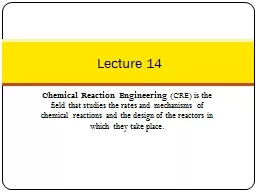

CRE is the field that studies the rates and mechanisms of chemical reactions and the design of the reactors in which they take place Lecture 14 Lecture 14 Thursday 2242011 Pseudo Steady State Hypothesis PSSH ID: 375802
Download Presentation The PPT/PDF document "Chemical Reaction Engineering" is the property of its rightful owner. Permission is granted to download and print the materials on this web site for personal, non-commercial use only, and to display it on your personal computer provided you do not modify the materials and that you retain all copyright notices contained in the materials. By downloading content from our website, you accept the terms of this agreement.
Slide1
Chemical Reaction Engineering (CRE) is the field that studies the rates and mechanisms of chemical reactions and the design of the reactors in which they take place.
Lecture
14Slide2
Lecture 14 – Thursday 2/24/2011
Pseudo Steady State Hypothesis (PSSH)
Net Rate of Reaction of Active Intermediates is Zero
Hall of Fame Reaction: 2NO +O2 2NO2Introduction to Enzyme KineticsBegin Non-Isothermal Reactor Design
2Slide3
An active intermediate
is a molecule that is in a highly energetic and reactive state It is short lived as it disappears virtually as fast as it is formed. That is, the net rate of reaction of an active intermediate, A*, is zero
.
The assumption that the net rate of reaction is zero is called the Pseudo Steady State Hypothesis (PSSH)
3Slide4
4Slide5
Example
The rate law for the reaction
is found from experiment to be
How did this rate law come about? Suggest a mechanism consistent with the rate law.
5Slide6
For reactions with active intermediates
, the reaction coordinated now
has trough in it and the active intermediate, A*, sits in this trough
6Slide7
Solution
7Slide8
Rates:
Rate laws:
Reaction (1) (1)
Reaction (2) (2)
Reaction (3) (3)
Relative Rates:
But C*
A
cannot be measured since it is so small
8
k
3
is defined
w.r.t
. A*Slide9
Net Rates:
Rate of Formation of Product
(4)
(5)
(6)
Solving for
9
Pseudo Steady State Hypothesis r*
A
= 0Slide10
Substituting for in Equation (4) the rate of formation of B is
(8)
Relative rates overall
(9)
10Slide11
For high concentrations of A, we can neglect with regard to
, i.e.,
and the rate law becomes
Apparent first order.
(10)
11Slide12
For low concentrations of A, we can neglect with regard to k
3
, i.e.,
and the rate law becomes
(11)
Apparent second order.
Dividing by k
3
and letting
k
’=k
2
/k
3
and
k
=k
1
we have the rate law we were asked to derive
(12)
12Slide13
What about
Active
Intermediates
13
Why so many Reactions Follow Elementary Rate LawsSlide14
The
reaction
2NO +O
2
2NO
2
has an elementary rate law
However… Look what happens to the rate as the temperature is increased.
Active Intermediates / Free Radicals (PSSH)
-r
NO2
T
14
Hall of Fame ReactionSlide15
Why does
the rate
law
decrease with increasing temperature?
Mechanism
:
(1)
(2)
(3)
15
Write Rate of formation of Product r
NO2
Note: k
3
is defined w.r.t. NO
2Slide16
16
Assume that all reactions are
elementary
reactions, such that:
Define
k
w.r.t
.
NO
3
*Slide17
The
net
reaction
rate for NO
3
* is the
sum
of the
individual
reaction
rates for NO
3
*:
17Slide18
18
Pseudo Steady State Hypothesis (PSSH)
The PSSH assumes that the
net rate
of species A* (in this case NO
3
*
) is zero.Slide19
Pseudo Steady State Hypothesis (PSSH)
19Slide20
Pseudo Steady State Hypothesis (PSSH)
The
result
shows
why
the rate
decreases
as
temperature
increases
.
20
-r
NO2
TSlide21
End of Lecture 14
21